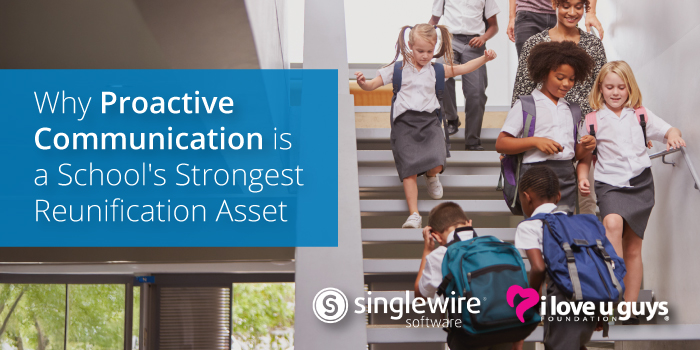The Pivotal Role of Communication
In the immediate aftermath of a school emergency, schools need to be able to demonstrate that they are in control of the situation, are putting student safety first, and can account for every student to reunite them with their parent or guardian. That all hinges on one pivotal element: communication.
Effective reunification isn’t just about getting students physically back into the care of their guardians; it’s about managing a chaotic, emotionally charged situation with clarity, accuracy, and efficiency. And in a time where misinformation often spreads faster than fact, proactive communication isn’t just a best practice—it’s a school’s strongest asset.
The Communication Chasm: A Common Challenge
During a webinar with The “I Love U Guys” Foundation on effective school reunification strategies, a consistent theme emerged: communication is a significant hurdle. It’s not just about reaching first responders; it’s about informing your own staff, delivering appropriate messages to students, and, perhaps most critically, communicating effectively with parents and the wider community.
Consider the alternative: In the absence of official, accurate information, parents will inevitably turn to other sources—local Facebook groups, neighborhood apps, or frantic phone calls to friends. This creates a vacuum that rumors and speculation quickly fill, escalating anxiety and potentially undermining trust in your school’s ability to manage a crisis.
Building Trust Before A Crisis
The time to build a robust communication strategy for reunification isn’t during an emergency; it’s long before. As our webinar panelists emphasized, you don’t want the first time parents hear about your reunification plan to be when they’re being called to pick up their child in a crisis.
Here’s why proactive, consistent communication is so vital:
- Educating your community: Informing parents about your reunification plan—the process, not necessarily the location—empowers them. Let them know what their role will be: having ID ready, understanding that there’s a structured process, and being patient. This pre-crisis education sets expectations and reduces potential frustration during an actual event.
- Building allies: When parents understand and appreciate your proactive safety measures, they become advocates. They can help spread accurate information and reinforce the importance of following official channels, becoming an invaluable asset in managing community perception during a crisis.
- Familiarity breeds confidence: Just as students practice fire drills, school staff need to practice communication protocols. Using a mass notification system to send messages about routine drills (e.g., lockdown drills, even adult-only reunification drills) gets your staff familiar with the system’s mechanics. It also helps parents recognize urgent communications, so when a real emergency occurs, they know the source and understand the gravity.
From Chaotic to Controlled Communication
Manually contacting every parent, fielding endless phone calls, and attempting to coordinate information across a sprawling campus are not just inefficient—they’re virtually impossible during a high-stakes emergency. This is where modern software tools become indispensable.
Integrated solutions can transform communication from a chaotic free-for-all into a controlled, efficient process:
- Targeted mass notifications: Systems that can send pre-configured messages to designated emergency contacts via email, text, or even voice can save time. This means you’re not blasting out sensitive information to the general public, but precisely targeting those who need to know.
- Pre-configured templates: Eliminate the stress of crafting messages under pressure. Having templates ready for various scenarios—initial notification, reunification site details, all-clear—ensures consistent, accurate, and timely communication. Just hit a button, and the message is out.
- Real-time accountability and information sharing: Beyond initial alerts, sophisticated reunification software provides a centralized dashboard for real-time student accountability. Teachers can update student statuses (present, injured, missing) from their devices, and this confidential information is immediately accessible to designated reunification teams. This prevents redundant calls, maintains privacy, and ensures resources are allocated effectively. It’s about knowing who is where, instantly and securely.
- Post-incident communication: Even after reunification is complete, the need for communication continues. Follow-up messages regarding school schedules, counseling services, or community resources are critical. A robust communication platform ensures you can maintain that vital connection with your families, further solidifying trust.
Communication as a Long-Term Investment
Thinking of communication solely as a reactive measure is a missed opportunity. Instead, view it as a continuous investment in community trust, operational efficiency, and overall school safety. By leveraging software solutions that facilitate proactive, targeted, and real-time messaging, you empower your school to navigate the complexities of emergencies with greater control and confidence.
When every parent knows their school has a plan, that their child’s safety is the priority, and that they will receive timely, accurate information, the answer to “Who owns the kids?” becomes profoundly reassuring: “We do, and we’re taking care of them.”
Ready to strengthen your school’s reunification communication strategy? Watch our recorded webinar, “Planning Together: Overcoming K-12 Reunification Challenges,” to gain further insights and practical recommendations from our expert panelists.
